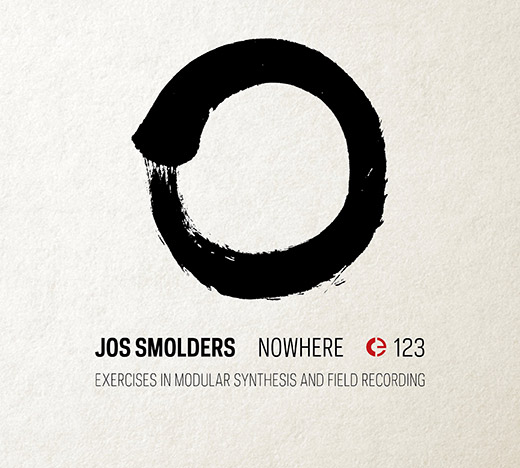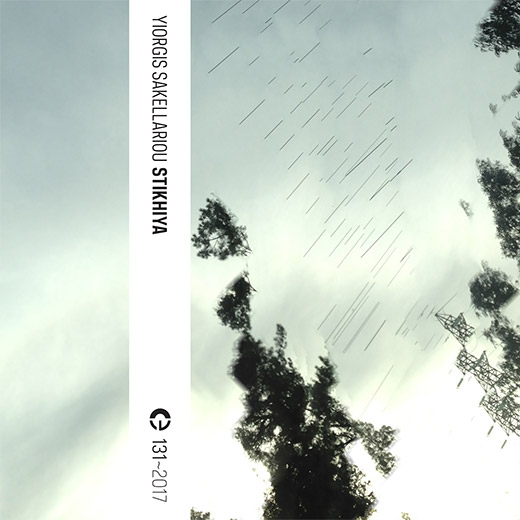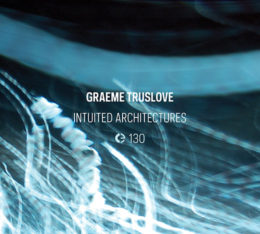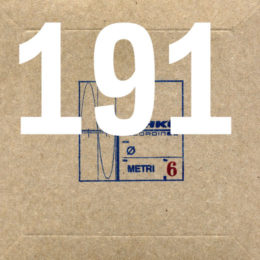New release: Graeme Truslove’s “Intuited Architecturesâ€

Graeme Truslove’s musical output so far has been divided between the opposing spheres of fixed-medium electroacoustic composition and improvised performance. All of the works presented in Intuited Architectures focus on integrating these conflicting extremes in various ways. Throughout their development, the creative processes employed shifted from the sculptural to the performative – from the creation of sonic mosaics, constructed from the careful placement of individual sonic impulses, to the recording and manipulation of performances on self-devised digital instruments. This shift arose initially through attempts to analyse and automate laborious micro-level techniques, however as the possibility to interact with these techniques in real-time emerged, so too did a number of unforeseen expressive possibilities. Montages became performances, which in turn became montages again. Central to all of the compositions is a preoccupation with musical time scales, ranging from the fabrication of synthetic timbres, via these performative-algorithmic approaches, through to their integration within larger-scale temporal strategies.
Graeme Truslove is a composer and performer based in Glasgow, Scotland. His output includes sonic and audio-visual compositions, and improvised music – playing guitar and/or laptop in various solo and collaborative projects. He holds both an M.Eng in Electronics with Music, and a Ph.D. in Music Composition from the University of Glasgow. He currently lectures in Composition and Music Technology at the University of the West of Scotland.
Truslove has performed and exhibited his work internationally, and has attracted awards and nominations from: Métamorphoses (Belgium, 1st prize), The Salford Sonic Research Commission (UK), Creative Scotland, The British Council, The Performing Rights Society Foundation PRSF (UK), The Dewar Arts Award (Scotland), Sociedad General de Autores y Editores SGAE (Spain), The Prince’s Trust (UK), The Phonos Foundation (Spain), The Lumen Prize (UK), The International Computer Music Association (USA).
Portals won 1st prize in the Métamorphoses 2010, 6th Biennial Acousmatic Composition Competition, and was released previously by Musiques & Recherches (MR2010). Suite II was created with support from the Dewar Arts Awards, Scotland. Elements was funded by a bursary from the Performing Rights Society Foundation, UK.
- Suite II, Portals (07:36)
- Suite II, Convergence (08:26)
- Suite II, Divergent Dialogues (08:19)
- Elements (08:22)
- Concrètisations X (14:45)
- Strata (20:24)
All pieces created 2004 to 2010 by Graeme Truslove.
Double Bass on Strata performed by George Lyle.
Photo by Alison Clifford.
Produced with support from The University of the West of Scotland.
Intuited Architectures is available as a limited-release CD and a digital download.
“Digital Junkies in Strange Times†reviewed by Rockerilla
Ran Slavin è un virtuoso del laptop, che si è ormai imposto nella cultura musicale contemporanea come uno strumento a sé a tutti gli e etti. E etti che nel caso della musica di Slavin si palesano in una manciata di pezzi techno dove a farla da padrone è un’ambient “sporca†e spuria nella quale si innestano spunti r’n’b a presa rapida. A farla da padrone nel suo nuovo disco sono ovviamente i 41 mastodontici minuti di Moonlight Compilations, che ricalca certi cerimoniali electro-minimal a base di musica cosmica, industrial, ambient e new age di Daniel Lopatin aka Oneohtrix Point Never. Massimo Padalino
“Hiku Komuro, Hikikomori†reviewed by Rockerilla
La Cronica non delude mai con le sue pubblicazioni e anche questa volta fa centro con la cassetta dell’artista spagnolo Durán Vázquez, autore di tracce sperimentali reperibili ovviamente anche in digitale. Il galiziano utilizza software di Windows, vecchi plug-ins degli anni 90, campionamenti da vecchi videogame anni 80 e varia strumentazione per un lavoro la cui ricerca sonora si muove tra isolazionismo ambient, musica concreta
e citazioni da un passato ludico (vedi i suoni dei videogiochi inseriti su un drone nel brano conclusivo di oltre 26 minuti). Gianluca Polverari
Soon in Crónica: Graeme Truslove’s “Intuited Architecturesâ€
“The Wayward Regional Transmissions†reviewed by Data.Wave

This is another chapter in our research project of Ran Slavin’s music, where we are listening to The Wayward Regional Transmissions.
Artwork of the album is very original, we are looking down to the desert’s surface from a satellite, while receiving a transmission or from the command centre. Every single of Ran’s releases is a new step into the unknown territory of sound. Listening to this album you transit to Oriental Abstract Spiritual Music and glitch, combined with experimental ethno-electronic music.
The first track Village mesmerizes with its folklore-like sounds. I don’t know was it in Middle East, India or someone from another planet, who invented musical instrument Bulbul Tarang, played by Ahuva Ozeri. You can listen for hours for its space-like sounds, and combined with the digital technology, this instrument produces
unpredictable and surprising results.
Have a listen to the spiritual and, at the same time, psychedelic track Wayward Initial. Its music levitates your consciousness above the vast space of Sahara desert and once you are ready to cast your eye to the horizon, it introduces a hard glitch, resembling a secret transmission from an unknown radio station directed at you.
Shelters and Peace has another level of sound, introduced by clicks’n’cuts – the air above the desert is hot and static, you are starting to see images of an oasis, jittering with each click.
DAT Beats – first loops and sounds remind us that we are still listening to electronic music. Ironic track Kiosk in Furadis with its colorful flying voices adds its own flavor and the picture turns unbelievably rich: Earth, space, sound, music, color. The only unfortunate thing about the track Hagalil – is that it is the last track of the album and that our Transmission is over.
“Nowhere: Exercises in Modular Synthesis and Field Recording†reviewed by Vital

Ten years ago J. Smolders quit developing work from preconceived compositions, planned into the smallest details. Since them, he has been using ways of work more undefined and fuzzy. While taking these steps, he cultivates states of deep concentration, and then he makes the work with a few quick touches. He uses these elements when he plays with the modular synths and the field recordings. He prepares, and then lets it all flow, keeping the original sounds simple and limiting the overdubs and the editing procedures, according to the main free form concept of “here and nowâ€. The sequences of Nowhere seem to be quite abstract, dilated, filled with hum and static discharges, cosmic hyperbole and crackle, feedback and distortions. The work has strong goals and is strong in its performing too, thanks to the unimpeachable work procedures.
“Stikhiya†reviewed by Vital

Let go theorizing, theories, rational reasoning. Strive for Stikhiya. Or: primitive immediacy. Then and there, organic holistic experiences (may) emerge, dixit Yorgis Sakellariou. It’s where unfathomable and formless forces of perception are at play; awe-inspiring, myth-making.
On his cassette Sakellariou manipulates field recordings from various sources; be it natural or technological/industrial, be it in the field or at home. The crash of a waterfall joins a fridge’s hum in a symphony of clashes and juxtapositions. Scratching and scraping, creepy and crawly, rumbling and bustling the aural zoo maintained by Sakellariou is teeming with lively action.
This projects a power of catharsis in as much as these works bear their elementary building blocks precisely to remain firmly rooted in reality, whilst rearranging these familiarities towards expansions of the real; a rarification, perfecting too – also in size of the sound field and scope of the emotional rapport. Sakellariou’s rawness of sound is worn on his sleeve; a throbbing heartbeat – the sound of what it means to be alive, hearing living – living hearing: here, now and with an eternal glimmer from the noise of stern stuff, from which epic is written. (SSK)
via Vital
“Intuited Architectures†reviewed by Vital

From Scotland Graeme Truslove bridges the divide between fixed-medium electroacoustic composition and performance based on improvisation. From meticulous structuring of aural mosaics with sonic impulses placed at exactly the right time, place, texturing et cetera, Truslove moved into the realms of the recording and manipulation of these works. Consequently and rather ironically, as technology advanced, these treatments of performances in themselves became montage-performances, which turned to be possible source material for further performance, montage and composition.
With an ‘ensemble’ of energetic electronics, brimming with activity, slowly modulating, finely attuned in terms of texture and timbre (ranging from polished glistens to rough and raw barbs and wires), augmented with double bass, Truslove explores musical time and musical time scales. It’s all on display here, pretty much easy to hear in full frontal focus. That is: the evolution of synthetic tones, textures and timbres from Truslove’s performative-algorithmic machines. And also: the tweaking thereof, the searching, embellishment and/or destruction – the immediate present and the slowly unfolding development – the sound in and of itself and the placement in something much (infinitely?) larger. Size-wise by the way not per se in terms of a filled out, drummed up, jazzed through jumble or huge through-composed symphonic effort, but above all in terms of strategies of time.
Long lines and thin spikes and fat bubbles and short gurgles for example bounce around in short-term presences, but together these also weave and bob in and out of an almost droning aural field out of time, beyond eternal music, too. It’s thanks to Truslove’s amazing touch for timbre and timing Intuited Architectures retains a splendid organic touch and feel, carving out a fascinating niche somewhere in the corner of acousmatic and electroacoustic music where the greats of the musique concrète meet ‘classical’ composers. A must-hear for all fans of the releases by INA-GRM, Recollecion GRM and Unsounds. (SSK)
via Vital
Futurónica 191

Episode 191 of Futurónica, a broadcast in Rádio Manobras (91.5 MHz in Porto, 18h30) and Rádio Zero (21h GMT, repeating on Tuesday at 01h) airs tomorrow, April 28th.
The playlist of Futurónica 191 is:
- Ø, Sisään (1994, Metri, Sähkö)
- Ø, Hornitus (1994, Metri, Sähkö)
- Ø, Kuvio (1994, Metri, Sähkö)
- Ø, JL-CSG I (1994, Metri, Sähkö)
- Ø, Muuntaja (1994, Metri, Sähkö)
- Ø, Hion (1994, Metri, Sähkö)
- Ø, Twin Bleebs (1994, Metri, Sähkö)
- Ø, Erit-Samat (1994, Metri, Sähkö)
- Ø, Lasi (1994, Metri, Sähkö)
- Ø, JL-CSG II (1994, Metri, Sähkö)
- Ø, Radio (1994, Metri, Sähkö)
- Ø, Asuntola (1994, Metri, Sähkö)
- Ø, Dayak (1994, Metri, Sähkö)
You can follow Rádio Zero’s broadcasts at radiozero.pt/ouvir and Rádio Manobras at radiomanobras.pt.


